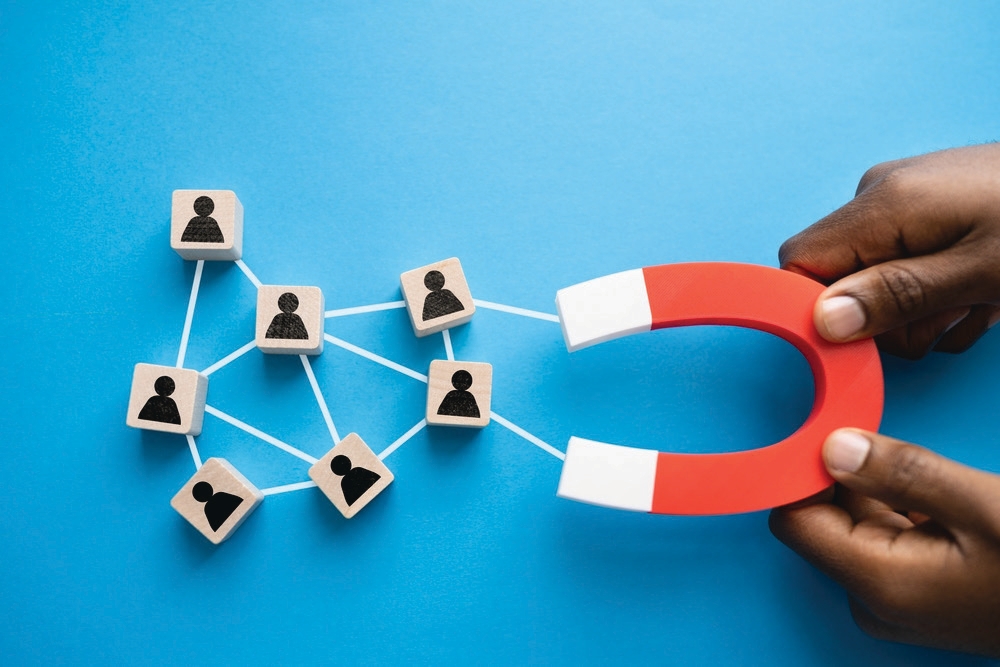In today’s competitive B2B arena, success hinges on a deep understanding of your target audience. Imagine launching a marketing campaign without a clear picture of who you’re trying to reach – it’s like sending out mass emails without a mailing list.
This is where buyer personas and customer profiles come in as powerful tools designed to help you laser-focus your marketing efforts.
While both concepts might seem similar, a key distinction separates them. Buyer personas are detailed fictional profiles of specific decision-makers within your ideal customer base. They go beyond demographics, providing insights into these key players’ goals, challenges, and even preferred communication styles. On the other hand, customer profiles offer a broader perspective on your existing customer landscape. These profiles are built using real data about your current clientele, revealing trends and commonalities that define your existing customer base.
However, differentiating buyer personas from customer profiles is vital for drafting effective B2B marketing strategies.
So, in this blog, we will understand each approach in more detail, helping you refine your marketing focus and reach the right B2B audience.
B2B Customer Profiles
Customer profiles are a tool that sheds light on your existing customers and what makes them relevant. It’s not a profile of a single person but rather a data-driven representation that captures the key characteristics of your existing customer base.
To understand in a better way, let’s break down what makes up a strong customer profile:
- Firmographics: Think of this as the ‘who’ and ‘where’ of your customer. It includes details like the size of their company, the industry they operate in, and where they’re located. This helps you understand their context and tailor your approach accordingly, like offering scalable solutions for larger enterprises or specialized services for specific industries and regions.
- Needs and Challenges: Delve into what keeps your customer up at night. Understanding their pain points and challenges allows you to position your products or services as solutions that directly address their concerns. It’s about being empathetic and offering real value by solving their problems.
- Buying Behaviors: Dive into how your customer makes decisions. This includes their decision-making process, how they research and evaluate options, and what budget constraints they might have. Understanding these behaviors helps you tailor your sales and marketing efforts to align with their preferences and constraints.
- Value Proposition for the Customer: Showcase why you’re the perfect fit for them. Highlight the unique benefits and value your products or services bring to the table. It’s about demonstrating how you can meet their needs better than anyone else, making it a no-brainer for them to choose you.
Benefits of Customer Profiles in B2B Marketing
Investing time and resources into creating insightful customer profiles in B2B marketing offers a multitude of results. Here are some advantages of customer profiles in the B2B arena:
- Targeted Marketing Campaigns: Understand your ideal customer’s firmographics, needs, and buying behaviors to create personalized messages that resonate deeper, ensuring marketing efforts are efficient and yield higher returns on investment.
- Improved Customer Segmentation: Divide your audience into distinct groups based on shared characteristics through customer segmentation. This enables personalized marketing messages and offers tailored to specific needs, resulting in increased engagement and conversion rates.
- Streamlined Sales Process: Use insights from customer buying behaviors to empower sales teams. They can customize their approach, identify key decision-makers, and effectively communicate value propositions, leading to shorter sales cycles and increased closures.
B2B Buyer Personas
Buyer personas are more detailed, fictionalized profiles of specific decision-makers within your ideal customer base. Creating effective B2B buyer personas goes beyond demographics, delving into the goals, motivations, and even preferred communication styles of these key influencers.
So, what makes up a strong buyer persona? Here’s a breakdown
- Demographics: Age, job title, and education level are a starting point, but don’t stop there. Consider factors like industry experience or company department.
- Goals and Motivations: What drives Sarah, the VP of IT? Is she laser-focused on improving efficiency or facing pressure to comply with industry regulations? Understanding her goals helps you tailor your message to resonate with her priorities.
- Information Consumption Habits: Does Sarah frequent industry blogs or rely on webinars to learn about new solutions? Knowing her preferred channels allows you to deliver your message where she’s looking.
- Challenges and Pain Points: What keeps Sarah up at night? Is she struggling with outdated security software or a lack of internal resources? Identifying her pain points allows you to position your product or service as the solution she needs.
- Objections and Buying Reservations: What might give Sarah pause before making a purchase? Understanding her potential hesitations allows you to proactively address them in your sales outreach.
Benefits of Buyer Personas
There are various ways in which buyer personas work in favor of creating better marketing strategies. Here are some benefits of B2B Buyer personas
- Content Tailored to Specific Needs: By understanding Sarah’s goals, challenges, and preferred information channels, you can create content that speaks directly to her needs. Imagine blog posts that address her security concerns or case studies featuring similar healthcare startups.
- Personalized Sales Outreach: Your sales team can ditch the generic pitches and tailor their approach to Sarah’s specific role and motivations. They can highlight how your product directly addresses her pain points.
- Improved Customer Journey Mapping: Buyer personas help you map out the different touchpoints Sarah might have with your brand throughout her buying journey. This allows you to optimize each stage for a smoother, more positive customer experience.
Key Differences Between Buyer Personas and Customer Profiles
| Feature | Buyer Persona | Customer Profile |
| Focus | Individuals (Decision-makers within ideal customer companies) | Companies (Your existing customer base) |
| Data Source | Research, assumptions, industry data | Existing customer data (CRM, surveys) |
| Level of Detail | In-depth understanding of goals, motivations, and behaviors | Broad view of company characteristics and buying behaviors |
| Stage in Buyer’s Journey | Top and middle funnel (Awareness, Consideration) | Throughout buyer’s journey (Awareness, Consideration, Decision) |
| Creation Process | Developed through a combination of research, industry data, and assumptions | Built on real data about your current customers |
| Benefits | – Content tailored to specific needs – Personalized sales outreach – Improved customer journey mapping | – Targeted marketing campaigns – Improved customer segmentation – Streamlined sales process |
When to Use Each Tool
Customer Profiles: Your blueprint for understanding your ideal customer company. Here’s when to leverage them:
- Market Segmentation & Targeting Existing Customers: Customer profiles help you segment your existing customer base into distinct groups with shared characteristics (industry, size, needs). This allows for targeted marketing campaigns and personalized offers that resonate with each segment.
- Long-Term Customer Retention Strategies: By understanding your customer profile’s needs and challenges, you can develop strategies to foster long-term relationships. This could involve loyalty programs, educational resources, or proactive communication about product updates that address their evolving needs.
- Aligning Product Development with Customer Needs: Customer profiles provide valuable insights into the challenges and pain points of your existing customer base. This information is crucial for informing product development and ensuring your offerings continue to meet their needs and remain competitive.
Buyer Personas: Your detailed representation of key decision-makers within your ideal customer companies. Here’s when to leverage them:
- Targeted Marketing Campaigns & Content: Buyer personas help you create content that speaks directly to the specific goals, challenges, and information consumption habits of your ideal decision-makers. This could involve targeted blog posts, social media campaigns, or white papers that address their pain points and showcase your solution as the ideal answer.
- Personalized Sales Outreach & Messaging: Tailoring your sales approach to address the specific challenges and objections of each buyer persona can significantly improve your success rate. Understanding their motivations and buying behaviors allows your sales team to craft personalized messages that resonate and build trust.
- Understanding the Decision-Making Process within Target Companies: Buyer personas shed light on the different stakeholders involved in the buying process within your target companies. This knowledge equips your sales team to connect with the right people at the right time and navigate the internal approval process more effectively.
Conclusion
Customer profiles and buyer personas are complementary tools that work hand-in-hand to paint a comprehensive picture of your B2B audience. By leveraging both, you gain a deeper understanding of your existing customers and the key decision-makers within your ideal customer companies. It will help you to craft targeted marketing messages, personalize your sales outreach, and ultimately achieve your B2B marketing goals.
Marketboats recognizes the transformative power of buyer personas and customer profiles in B2B marketing strategies. We offer a comprehensive suite of tools and resources specifically designed to delegate you in developing vital buyer personas and drafting targeted campaigns that demonstrably drive results.
Contact us for more details!






